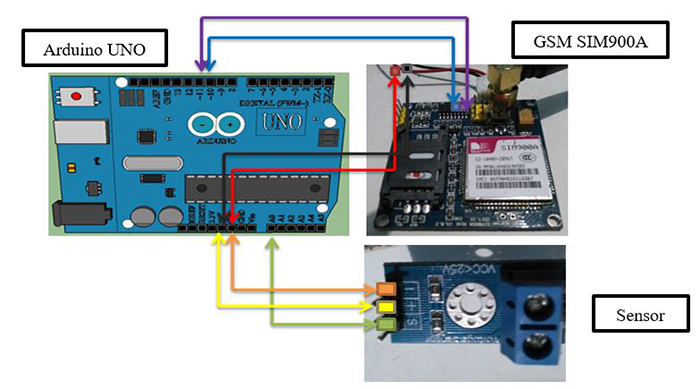Arduino-Based Battery Voltage Monitoring and SMS Gateway
DOI:
https://doi.org/10.12928/biste.v2i3.1478Keywords:
Baterai, Sensor tegangan, State of Charge, SMS Gateway, Pemantauan bateraiAbstract
This study aims to monitor the value of the voltage on the battery using a voltage sensor and using the State of Charge method to estimate the charged power of the VRLA battery remotely by utilizing SMS Gateway-based technology so that checking is no longer necessary. The results obtained are displayed on the smartphone in the form of an SMS. To determine the SOC in a 12V VRLA battery, it is calculated based on the number of each cell. VRLA 12V has 6 cells, each cell consisting of 2V to 2.4Volt. The capacity of a VRLA battery in 1 cell is declared 100% full at a voltage of 2.3 volts. So that data is obtained to determine the full percentage of the VRLA 12V 6 cell battery with a capacity of 7.2Ah, namely 13.8V. Experiments were carried out using solar panels, VRLA batteries, voltage sensors, Arduino UNO, and GSM SIM900A modules. This study succeeded in reading the measured voltage value with the sensor, and obtained an error value of 0.20 and a standard deviation of 0.02, and for the monitoring process to run smoothly without problems.
References
S. Raharjo, “Studi karakterisasi pembuatan optical phasa conductor untuk kondisi iklim tropis indonesia,” TRAKSI : Majalah Ilmiah Teknik Mesin vol. 13, no. 2, 2016. DOI: 10.26714/traksi.13.2.2013.%25p
A. U. Azmy and M. A. Riyadi, “Sistem Tracking Panel Surya Untuk Pengoptimalan Daya Menggunakan Metode Kontrol Self-Tuning Pid Dengan Jst Jenis Perceptron,” vol. 17, no. 1, pp. 35–41, 2015, DOI: 10.12777/transmisi.17.1.35-41
M. Fhery and N. Idris, “Perancangan Sistem Kelistrikan pada Kapal Nelayan Menggunakan Panel Surya,” vol. 4, no. 2, pp. 2–5, 2019. DOI: 10.33772/jfe.v4i2.6570
M. Chanif, S. Sarwito, and E. S. K, “Analisa Pengaruh Penambahan Kapasitor Terhadap Proses Pengisian Baterai Wahana Bawah Laut,” J. Tek. Pomits, vol. 3, no. 1, pp. 1–6, 2014. DOI: 10.12962/j23373539.v3i1.5814
R. D. Listianto, S. Sunardi, and R. D. Puriyanto, “Monitoring Tegangan Baterai Lithium Polymer pada Robot Sepak Bola Beroda secara Nirkabel,” Bul. Ilm. Sarj. Tek. Elektro, vol. 1, no. 1, p. 1, 2019, doi: 10.12928/biste.v1i1.826. DOI: 10.12928/biste.v1i1.826
A. F. Farizy and D. A. Asfani, “Desain Sistem Monitoring State Of Charge Baterai Pada Charging Station Mobil Listrik Berbasis Fuzzy Logic Dengan Mempertimbangkan Temperature,” J. Tek. ITS, vol. 5, no. 2, 2016. DOI: 10.12962/j23373539.v5i2.16203
B. Sugeng and R. H. Saputra, “Estimasi State-Of-Charge Menggunakan Simulink Pada Baterai Pembangkit Listrik Tenaga Surya,” J. ELTIKOM, vol. 3, no. 1, pp. 1–8, 2019. DOI: 10.31961/eltikom.v3i1.89
A. Qurthobi, A. B. K. Pambudi, D. Darmawan, and R. F. Iskandar, “Correlation between battery voltage under loaded condition and estimated state of charge at valve-regulated lead acid battery on discharge condition using open circuit voltage method,” Int. J. Power Electron. Drive Syst., vol. 9, no. 1, pp. 357–364, 2018. DOI: 10.11591/ijpeds.v9.i1.pp357-364
A. Nugroho and E. Rijanto, “Simulasi Optimasi Pengukuran State of Charge Baterai Dengan Integral Observer,” Widyariset, vol. 17, no. 3, pp. 323–332, 2014. DOI: 10.14203/widyariset.17.3.2014.323-332
R. I. Putra, S. Sunardi, and R. D. Puriyanto, “Monitoring Tegangan Baterai Lithium Polymer pada Robot Line Follower Secara Nirkabel,” Bul. Ilm. Sarj. Tek. Elektro, vol. 1, no. 2, pp. 73-81, 2019. DOI: 10.12928/biste.v1i2.907
Winasis, A. W. W. Nugraha, I. Rosyadi, “Desain sistem monitoring nirkabel berbasis website untuk pemantauan baterai dan beban pembangkit listrik hibrida surya - angin,” Jurnal Teknik Elektro-ITP, vol. 5, no. 2, pp. 137–142, 2016. Online
Y. Astriani, A. Kurniasari, E. R. Priandana, and N. A. Aryono, “Penyeimbangan State of Charge Baterai Lead Acid Pada Prototipe Battery Management System a Prototype Battery Management System for Balancing,” vol. 17, no. 1, pp. 43–52, 2018. Online

Downloads
Published
How to Cite
Issue
Section
License
Copyright (c) 2020 Muhammad Setiawan, Riky Dwi Puriyanto

This work is licensed under a Creative Commons Attribution-ShareAlike 4.0 International License.
Authors who publish with this journal agree to the following terms:
- Authors retain copyright and grant the journal right of first publication with the work simultaneously licensed under a Creative Commons Attribution License that allows others to share the work with an acknowledgment of the work's authorship and initial publication in this journal.
- Authors are able to enter into separate, additional contractual arrangements for the non-exclusive distribution of the journal's published version of the work (e.g., post it to an institutional repository or publish it in a book), with an acknowledgment of its initial publication in this journal.
- Authors are permitted and encouraged to post their work online (e.g., in institutional repositories or on their website) prior to and during the submission process, as it can lead to productive exchanges, as well as earlier and greater citation of published work (See The Effect of Open Access).
This journal is licensed under a Creative Commons Attribution-ShareAlike 4.0 International License.


